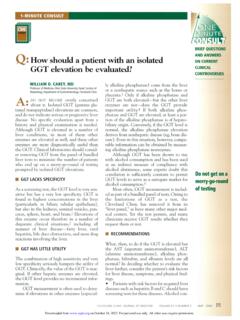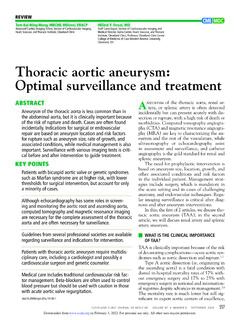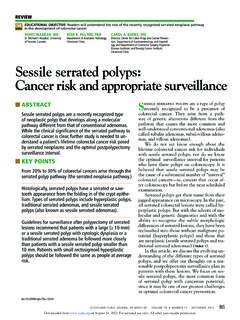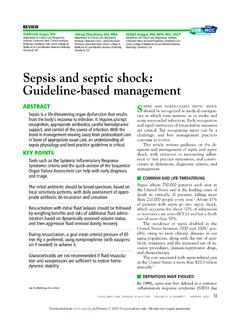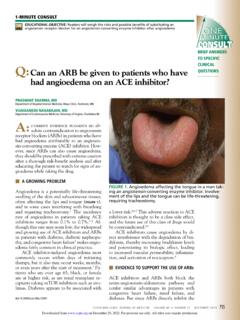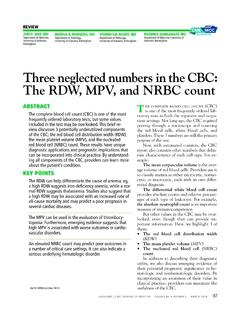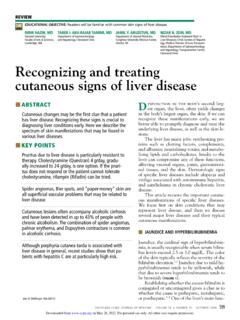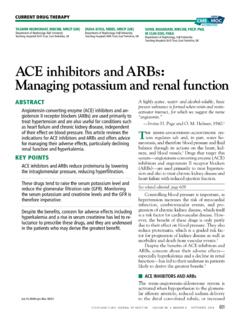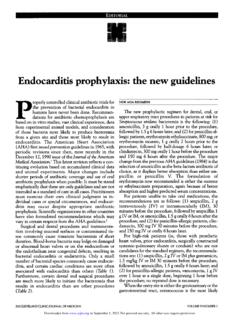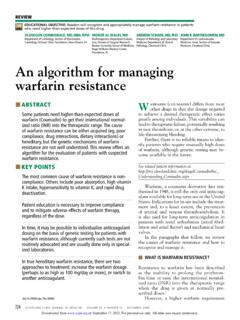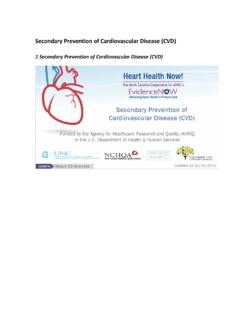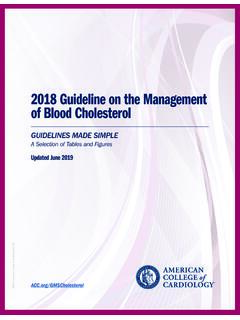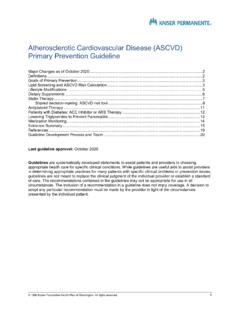Transcription of ACC/AHA lipid guidelines: Personalized care to prevent ...
1 REVIEW Cara Reiter-Brennan CME MOC Johns Hopkins Ciccarone Center for Prevention of cardiovascular Disease, Baltimore, MD; Department of Radiology and Neuroradiology, Charit , Berlin, Germany Albert D. Osei, MD, MPH. Johns Hopkins Ciccarone Center for Prevention of cardiovascular Disease, Baltimore, MD. S. M. Iftekhar Uddin, MBBS, MSPH. Johns Hopkins Ciccarone Center for Prevention of cardiovascular Disease, Baltimore, MD. Olusola A. Orimoloye, MD, MPH. Johns Hopkins Ciccarone Center for Prevention of ACC/AHA lipid guidelines : cardiovascular Disease, Baltimore, MD; Depart- ment of Medicine, Vanderbilt University School of Medicine, Nashville, TN. Personalized care to prevent Olufunmilayo H. Obisesan, MD, MPH. Johns Hopkins Ciccarone Center for Prevention of cardiovascular Disease, Baltimore, MD.
2 cardiovascular disease Mohammadhassan Mirbolouk, MD. Johns Hopkins Ciccarone Center for Prevention of cardiovascular Disease, Baltimore, MD; Depart- ment of Medicine, Yale School of Medicine, New Haven, CT. Michael J. Blaha, MD, MPH. ABSTRACT Johns Hopkins Ciccarone Center for Prevention of cardiovascular Disease, Baltimore, MD. The 2018 and 2019 guidelines from the American College of Cardiology Omar Dzaye, MD, PhD. and American Heart Association re ect the complexity of individualized Johns Hopkins Ciccarone Center for Prevention of cholesterol management. The documents address more detailed risk as- cardiovascular Disease, Baltimore, MD; Russell H. Morgan Department of Radiology and Radiological sessment, newer nonstatin cholesterol-lowering drugs, special attention Science, Johns Hopkins University School of Medi- cine, Baltimore, MD; Department of Radiology and to patient subgroups, and consideration of the value of therapy, all with Neuroradiology, Charit , Berlin, Germany the aim of creating Personalized treatment plans for each patient.
3 Overall, the guidelines recommend shared decision-making to meet the individual needs of each patient. KEY POINTS he American College of Cardiology Emphasize a heart-healthy lifestyle for all patients across T (ACC) and American Heart Associa- tion (AHA) Task Force on Clinical Practice their life span. guidelines published its most recent guide- lines for cholesterol management in 2018,1. A discussion with the patient is the cornerstone of shared and followed it with guidelines for primary decision-making and should include the patient's 10-year prevention of cardiovascular disease in risk of atherosclerotic cardiovascular disease according to the Pooled Cohort Equations, as well as risk-enhancing The new guidelines have updated patient factors.
4 Risk assessment and treatment options in pri- mary and secondary prevention. In primary prevention, the guidelines provide clarity re- Statins are the foundation of pharmacologic therapy, garding decision-making in patients at inter- to which ezetimibe and, if necessary, a proprotein con- mediate risk of atherosclerotic cardiovascular vertase subtilisin/kexin type 9 inhibitor can be added to disease ( intermediate meaning a 20%. achieve lipid goals. 10-year risk). In secondary prevention, the guidelines Special treatment algorithms are outlined for certain group patients according to their risk (high patient subgroups, such as certain ethnic groups, adults risk vs very high risk) and incorporate new with chronic kidney disease, those with human immuno- nonstatin therapies as add-on, evidence-based de ciency virus infection, and women.
5 Treatment options when low-density lipopro- tein (LDL-C) remains above the 70 mg/dL. threshold. The guidelines also discuss the cost and value of each treatment option for each treatment group. CLEVELAND CLINIC JOURNAL OF MEDICINE VOLUME 87 NUMBER 4 APRIL 2020 231. Downloaded from on January 9, 2022. For personal use only. All other uses require permission. lipid guidelines . Here, we review the recent guidelines and Fluvastatin 20 40 mg daily discuss the most important changes for clinical Lovastatin 20 mg daily 3 Pravastatin 10 20 mg daily Simvastatin 10 mg daily. CLASSES OF RECOMMENDATION, LEVELS OF EVIDENCE Nonstatin drugs The nonstatin LDL-lowering drugs such as The guidelines award classes of recommenda- ezetimibe and proprotein convertase subtili- tions, signifying the certainty of benefit com- sin/kexin type 9 (PCSK9) inhibitors can be pared with the estimated risk and the strength added to statin therapy, as recent randomized of the recommendation.
6 Clinical trials found them to improve cardio- Class I (strong) benefit greatly exceeds vascular outcomes in patients with atheroscle- risk; treatment is recommended rotic cardiovascular 7. Class IIa (moderate) benefit exceeds Ezetimibe decreases cholesterol absorp- risk; treatment is reasonable tion and consequently lowers LDL-C levels Class IIb (weak) benefit equals or ex- by about 20%. A large randomized trial in ceeds risk; treatment might be reasonable patients who recently had acute coronary Class III: No benefit (moderate) benefit syndromes showed that ezetimibe modestly equals risk; treatment is not recommended reduced cardiovascular risk over 7 years of Class III: Harm (strong) risk exceeds follow-up when added to their regimen of benefit.
7 Moderate-intensity statin ,5. The guidelines also award levels of evi- PCSK9 inhibitors lower LDL-C by 50%. dence to their recommendations: to 60% by binding to PCSK9, inhibiting la- Level A high-quality evidence beling of LDL receptors for degradation, thus Level B-R moderate-quality evidence prolonging LDL receptor activity at the cell from randomized controlled trials membrane. Several trials showed that PCSK9. Level B-NR moderate quality evidence inhibitors reduce cardiovascular risk in pa- from nonrandomized trials tients with stable atherosclerotic cardiovascu- In addition to lar disease or recent acute coronary syndromes Level C-LD limited data a heart-healthy Level C-EO expert opinion. who are already on moderate- or high-intensi- lifestyle, statins ty statin ,6,7.
8 STATINS AND OTHER OPTIONS. are the founda- PRIMARY PREVENTION. In addition to a heart-healthy lifestyle (which tion of lipid should be encouraged for all patients across The new guidelines advocate a multifaceted management their life course), statins are the foundation of approach to primary prevention of atheroscle- lipid management. Statin therapy is divided rotic cardiovascular disease through cholester- into 3 categories of intensity: ol management. As the risk due to high cho- High-intensity, aiming for at least a 50% lesterol levels is cumulative over the life span, reduction in LDL-C. Examples: the guidelines encourage lifestyle therapy for Atorvastatin 40 80 mg daily primary prevention at all ages and in all patient Rosuvastatin 20 40 mg daily.
9 Categories. Additionally, they outline decision Moderate-intensity, aiming at a 30% to algorithms to create a therapy that suits the in- 49% reduction in LDL-C. Examples: dividual needs of each patient (Table 1). Atorvastatin 10 20 mg Statin bene t groups Fluvastatin 80 mg daily The new guidelines keep the same statin benefit Lovastatin 40 80 mg groups defined in the previous (2013) ACC/AHA . Pitavastatin 1 4 mg daily Statin therapy recommendations are Pravastatin 40 80 mg daily specifically given for the following groups: Rosuvastatin 5 10 mg Simvastatin 20 40 mg daily. Adults with severe hypercholesterolemia Low-intensity, aiming at a LDL-C reduc- If a patient age 20 to 75 has LDL-C levels of tion of less than 30%. Examples: 190 mg/dL or higher, you do not need to cal- 232 CLEVELAND CLINIC JOURNAL OF MEDICINE VOLUME 87 NUMBER 4 APRIL 2020.
10 Downloaded from on January 9, 2022. For personal use only. All other uses require permission. REITER-BRENNAN AND COLLEAGUES. TABLE 1. Primary preventive therapy in different patient subgroups Severe hypercholesterolemia Initiate high-intensity statin therapy immediately, irrespective of 10-year risk of atherosclerotic cardiovascular disease (ASCVD). Adding ezetimibe is reasonable if low-density lipoprotein cholesterol (LDL-C) is 190 mg/dL or there is less than 50% reduction in LDL-C levels with maximal tolerated statins Consider adding a proprotein convertase subtilisin/kexin type 9 (PCSK9) inhibitor in patients with heterozygous familial hypercholesterolemia or with LDL-C 220 mg/dL with maximally tolerated statins and ezetimibe Diabetes mellitus in adults Irrespective of 10-year ASCVD risk, initiate moderate-intensity statin therapy immediately Aim for reduction of LDL-C by at least 50%.
